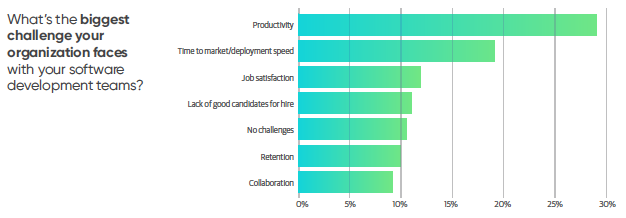To follow up on our previous survey about low-code and no-code tools, we decided to run another short survey about tools specifically for software developers—including, but not limited to, GitHub Copilot and ChatGPT. We’re interested in how “developer enablement” tools of all sorts are changing the workplace. Our survey 1 showed that while these tools increased productivity, they aren’t without their costs. Both upskilling and retraining developers to use these tools are issues.
Few professional software developers will find it surprising that software development teams are respondents said that productivity is the biggest challenge their organization faced, and another 19% said that time to market and deployment speed are the biggest challenges. Those two answers are almost the same: decreasing time to market requires increasing productivity, and improving deployment speed is itself an increase in productivity. Together, those two answers represented 48% of the respondents, just short of half.
HR issues were the second-most-important challenge, but they’re nowhere near as pressing. 12% of the respondents reported that job satisfaction is the greatest challenge; 11% said that there aren’t good job candidates to hire; and 10% said that employee retention is the biggest issue. Those three challenges total 33%, just one-third of the respondents.

It’s heartening to realize that hiring and retention are still challenges in this time of massive layoffs, but it’s also important to realize that these issues are less important than productivity.
But the big issue, the issue we wanted to explore, isn’t the challenges themselves; it’s what organizations are doing to meet them. A surprisingly large percentage of respondents (28%) aren’t making any changes to become more productive. But 20% are changing their onboarding and upskilling processes, 15% are hiring new developers, and 13% are using self-service engineering platforms.
We found that the biggest struggle for developers working with new tools is training (34%), and another 12% said the biggest struggle is “ease of use.” Together, that’s almost half of all respondents (46%). That was a surprise, since many of these tools are supposed to be low- or no-code. We’re thinking specifically about tools like GitHub Copilot, Amazon CodeWhisperer, and other code generators, but almost all productivity tools claim to make life simpler. At least at first, that’s clearly not true. There’s a learning curve, and it appears to be steeper than we’d have guessed. It’s also worth noting that 13% of the respondents said that the tools “didn’t effectively solve the problems that developers face.”
Over half of the respondents (51%) said that their organizations are using self-service deployment pipelines to increase productivity. Another 13% said that while they’re using self-service pipelines, they haven’t seen an increase in productivity. So almost two-thirds of the respondents are using self-service pipelines for deployment, and for most of them, the pipelines are working—reducing the overhead required to put new projects into production.
Finally, we wanted to know specifically about the effect of GitHub Copilot, ChatGPT, and other AI-based programming tools. Two-thirds of the respondents (67%) reported that these tools aren’t in use at their organizations. We suspect this estimate is lowballing Copilot’s actual usage. Back in the early 2000s, a widely quoted survey reported that CIOs almost unanimously said that their IT organizations weren’t making use of open source. How little they knew! Actual usage of Copilot, ChatGPT, and similar tools is likely to be much higher than 33%. We’re sure that even if they aren’t using Copilot or ChatGPT on the job, many programmers are experimenting with these tools or using them on personal projects.
What about the 33% who reported that Copilot and ChatGPT are in use at their organizations? First, realize that these are early adopters: Copilot was only released a year and a half ago, and ChatGPT has been out for less than a year. It’s certainly significant that they (and similar tools) have grabbed a third of the market in that short a period. It’s also significant that making a commitment to a new way of programming—and these tools are nothing if not a new kind of programming—is a much bigger change than, say, signing up for a ChatGPT account.
11% of the respondents said their organizations use Copilot and ChatGPT, and that the tools are primarily useful to junior developers; 13% said they’re primarily useful to senior developers. Another 9% said that the tools haven’t yielded an increase in productivity. The difference between junior and senior developers is closer than we expected. Common wisdom is that Copilot is more of an advantage to senior programmers, who are better able to describe the problem they need to solve in an intricate set of prompts and to notice bugs in the generated code quickly. Our survey hints that the difference between senior and junior developers is relatively small—although they’re almost certainly using Copilot in different ways. Junior developers are using it to learn and to spend less time solving problems by looking up solutions on Stack Overflow or searching online documentation. Senior developers are using it to help design and structure systems, and even to create production code.
Is developer productivity an issue? Of course; it always is. Part of the solution is improved tooling: self-service deployment, code-generation tools, and other new technologies and ideas. Productivity tools—and specifically the successors to tools like Copilot—are remaking software development in radical ways. Software developers are getting value from these tools, but don’t let the buzz fool you: that value doesn’t come for free. Nobody’s going to sit down with ChatGPT, type “Generate an enterprise application for selling shoes,” and come away with something worthwhile. Each has its own learning curve, and it’s easy to underestimate how steep that curve can be. Developer productivity tools will be a big part of the future; but to take full advantage of those tools, organizations will need to plan for skills development.
Source of Article



